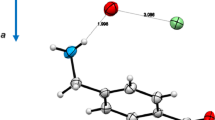Abstract
The synthesis and structures of two dicopper(I,I)-1,8-naphthyridine-2,7-diimine “crescent” complexes are presented. The four nearly coplanar nitrogen atoms of the crescent—two from naphthyridine and two from imines—house the dicopper(I,I) centers, which are bridged by two bromide ligands (1a) or two iodide ligands (1b) folded down from the copper–copper direction. The copper(I)-copper(I) distances are short and comparable (ca. 2.686 Å for 1a and ca. 2.620 Å for 1b). Each complex crystallizes in the triclinic space group P − 1 (#2): 1a as the acetonitrile solvate C22H28Cu2Br2N4.C2H3N has unit cell parameters a = 8.8941(10) Å, b = 9.0228(11) Å, c = 16.5475(16) Å, α = 95.956(6)°, β = 90.198(6)°, γ = 101.446(6)°, volume 1294.1(2) Å3, Z = 2; 1b as the acetonitrile solvate C22H28Cu2I2N4. 2C2H3N has unit cell parameters a = 11.6960(10) Å, b = 12.2839(11) Å, c = 12.5819(11) Å, α = 75.508(4)°, β = 65.947(5)°, γ = 64.910 (5)°, volume 1488.4(2) Å3, Z = 2. The complexes display long-lived stability (years) in the solid state.
Graphical Abstract
The syntheses and structural characterizations of dibromo-bridged and diiodo-bridged dicopper(I,I)-1,8-naphthyridine-2,7-di(N-cyclohexyl)methanimine crescent complexes are presented.







Similar content being viewed by others
References
Munakata M, Maekawa M, Kitagawa S, Adachi M, Masuda H (1990) Synthesis, properties and crystal structures of dicopper(I) and disilver(I) complexes with 1,8-naphthyridine (napy): [Cu2(napy)2](ClO4)2 and [Ag2(napy)2](ClO4)2. Inorg Chim Acta 167:181–188. https://doi.org/10.1016/S0020-1693(00)80495-8
He C, Lippard SJ (2000) Synthesis and characterization of several dicopper(I) complexes and a spin-delocalized dicopper (I, II) mixed-valence complex using a 1,8-naphthyridine-based dinucleating ligand. Inorg Chem 39:5225–5231. https://doi.org/10.1021/ic0005339
Ziegler MS, Lakshmi KV, Tilley TD (2017) Dicopper Cu(I)Cu(I) and Cu(I)Cu(II) complexes in copper-catalyzed azide-alkyne cycloaddition. J Am Chem Soc 139:5378–5386. https://doi.org/10.1021/jacs.6b13261
Evens G, Caluwe P (1979) Poly(1,8-naphthyridines) and 1,9,10-anthyridines: model systems for “Black Orlon.” Macromolecules 12:803–808. https://doi.org/10.1021/ma60071a002
Tikkanen WR, Kruger C, Bomben KD, Jolly WL, Kaska WC, Ford PC (1984) Synthesis, characterization, and x-ray molecular structures of mono- and dinuclear copper complexes of 2,7-bis-(2-pyridyl)-1,8-naphthyridine. Inorg Chem 23:3633–3638. https://doi.org/10.1021/ic00190a041
Hung M-U, Liao B-S, Liu Y-H, Peng S-M, Liu S-T (2014) Dicopper complexes catalyzed coupling/cyclization of 2-bromobenzoic acids with amidines leading to quinazolinones. Appl Organomet Chem 28:661–665. https://doi.org/10.1002/aoc.3177
Vu C, Walker D, Wells J, Fox S (2002) Elaboration of 1,8-naphthyridine-2,7-dicarboxaldehyde into novel 2,7-dimethylimine derivatives. J Heterocyclic Chem 39:829–832. https://doi.org/10.1002/jhet.5570390432
Fox S, Fronczek FR, Valente EJ (2008) Abstracts of 235th ACS National Meeting, New Orleans, LA, April 6–10, INOR-159
Dutta I, De S, Yadav S, Mondol R, Bera JK (2017) Aerobic oxidative coupling of alcohols and amines towards imine formation by a dicopper(I, I) catalyst. J Organomet Chem 849–850:117–124. https://doi.org/10.1016/j.jorganchem.2017.05.009
Kubas GJ, Monzyk B, Crumbliss AL (1979) Tetrakis(acetonitrile)copper(I) hexafluorophosphate. Inorg Synth 19:90–92. https://doi.org/10.1002/9780470132500.ch18
Altomare A, Burla MC, Camalli M, Cascarano GL, Giacovazzo C, Guagliardi A, Moliterni AGG, Polidori G, Spagno R (1999) SIR97: a new tool for crystal structure determination and refinement. J Appl Cryst 32:115–119. https://doi.org/10.1107/S0021889898007717
Sheldrick GM (2015) Crystal structure refinement with SHELXL. Acta Cryst C71:3–8. https://doi.org/10.1107/S2053229614024218
Clougherty L, Sousa J, Wyman G (1957) Notes—C=N stretching frequency in infrared spectra of aromatic azomethines. J Org Chem 22:462. https://doi.org/10.1021/jo01355a618
Seth DK, Bhattacharya S (2011) Copper(I) complexes of N-(aryl)pyridine-2-aldimines: spectral, electrochemical and catalytic properties. Polyhedron 30:2438–2443. https://doi.org/10.1016/j.poly.2011.05.037
Skelton BW, Waters AF, White AH (1991) Lewis-base adducts of group 11 metal(I) compounds. LXIII. Stereochemistries and structures of the 1:1 adducts of Cu1X (X = Cl, Br, I) with 2,2’-bipyridine. Aust J Chem 44:1207–1215. https://doi.org/10.1071/CH9911207
de Boer SY, Gloaguen Y, Lutz M, van der Vlugt JI (2012) CuI click catalysis with cooperative noninnocent pyridylphosphine ligands. Inorg Chim Acta 380:336–342. https://doi.org/10.1016/j.ica.2011.10.037
Araki H, Tsuge K, Sasaki Y, Ishizaka S, Kitamura N (2005) Luminescence ranging from red to blue: a series of copper(I)-halide complexes having rhombic{Cu2(μ-X)2} X = Br and I) units with N-heteroaromatic ligands. Inorg Chem 44:9667–9675. https://doi.org/10.1021/ic0510359
Fox S, Conger R (2018) Abstracts of 256th ACS National Meeting, Boston, MA, August 19–23, INOR-221
Conger R, Fox S (2018) Abstracts of 256th ACS National Meeting, Boston, MA, August 19–23, INOR-180
Author information
Authors and Affiliations
Corresponding author
Additional information
Publisher's Note
Springer Nature remains neutral with regard to jurisdictional claims in published maps and institutional affiliations.
Rights and permissions
About this article
Cite this article
Boehm, E.D., Fronczek, F.R. & Fox, S. Dibromo and Diiodo-Bridged Dicopper(I,I) Complexes of 1,8-Naphthyridine-2,7-Di(N-cyclohexyl)methanimine. J Chem Crystallogr 52, 485–493 (2022). https://doi.org/10.1007/s10870-022-00920-w
Received:
Accepted:
Published:
Issue Date:
DOI: https://doi.org/10.1007/s10870-022-00920-w




